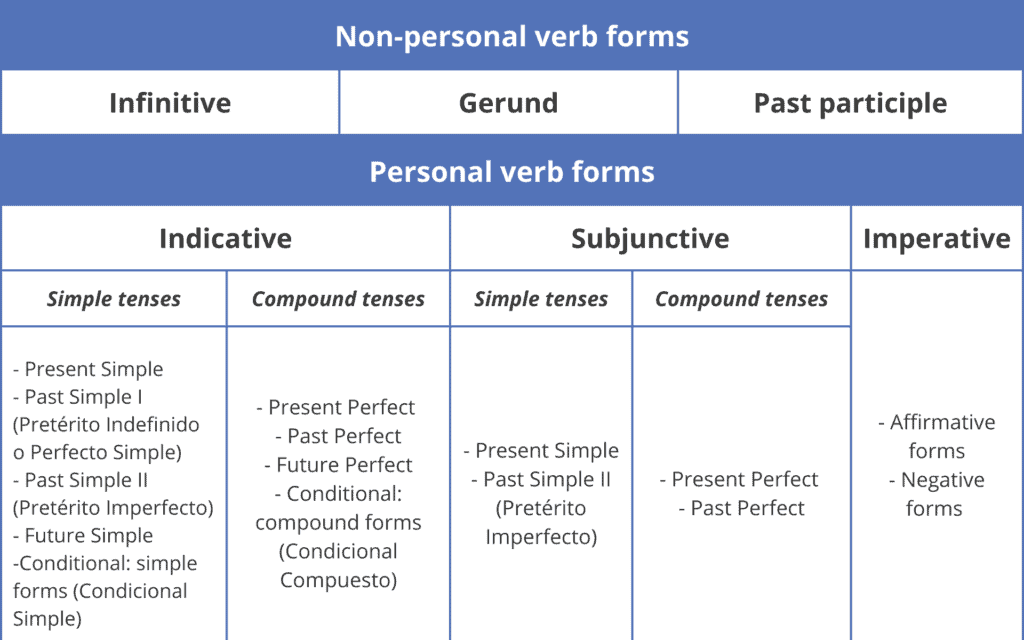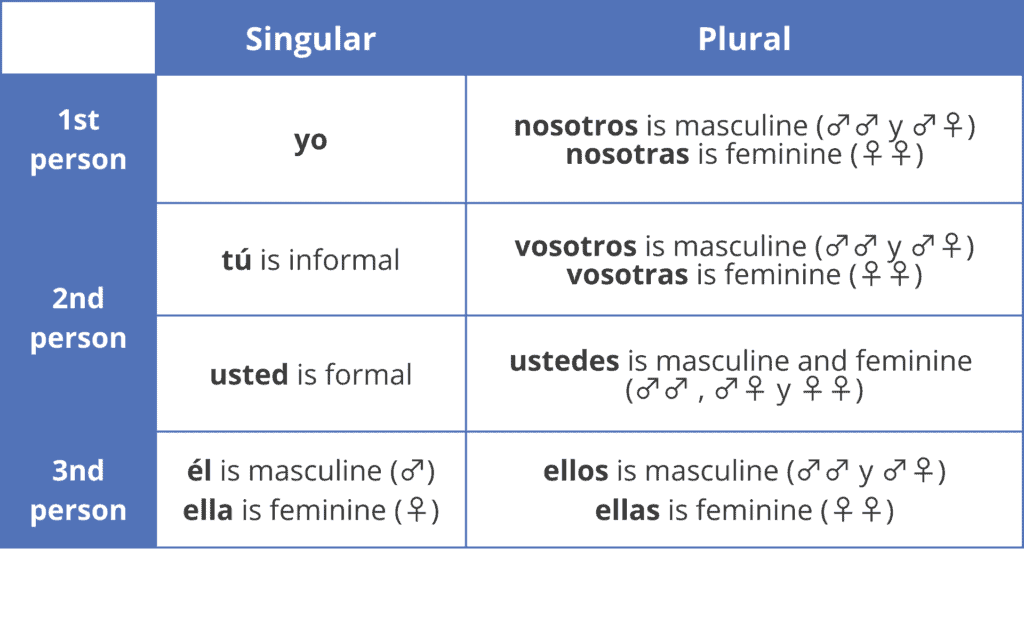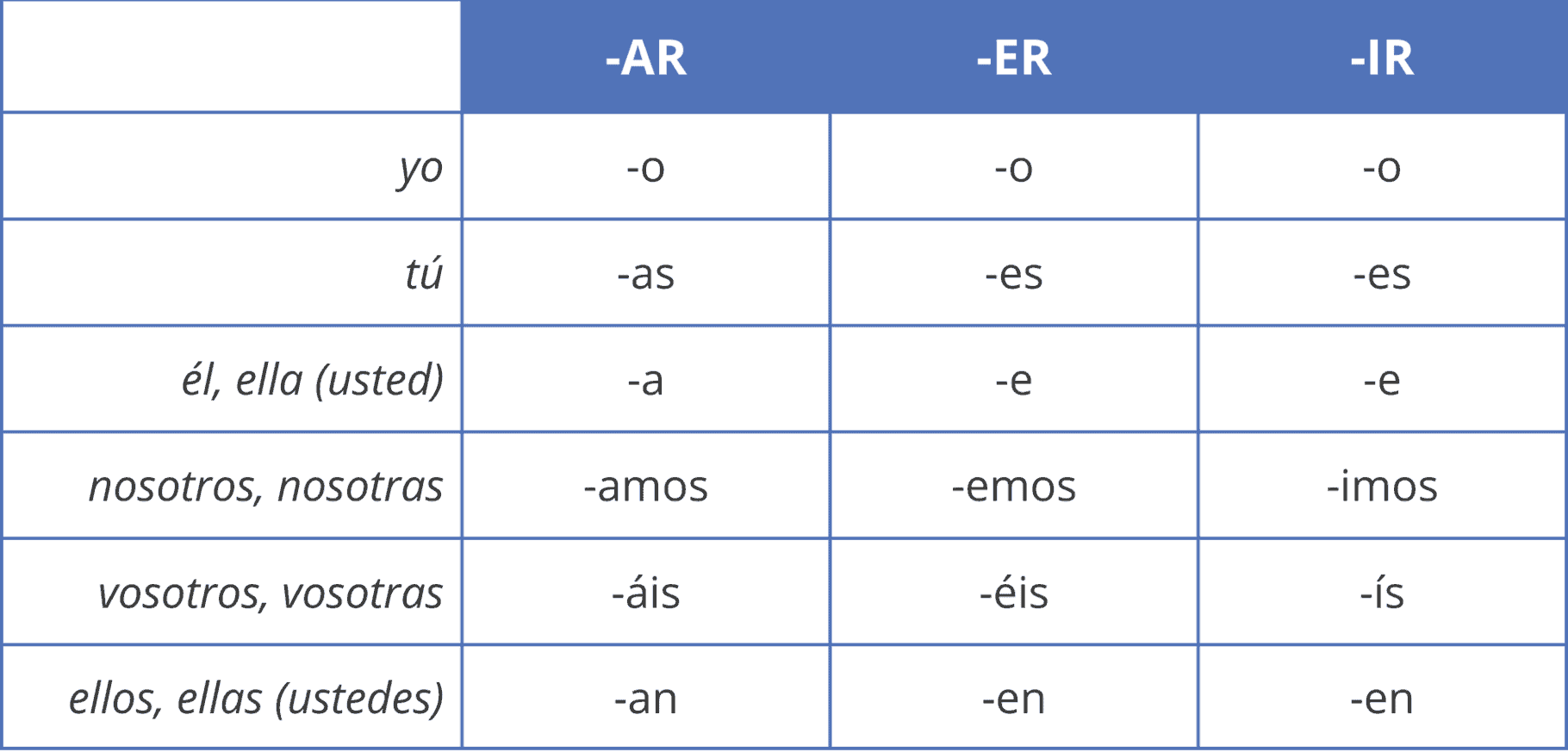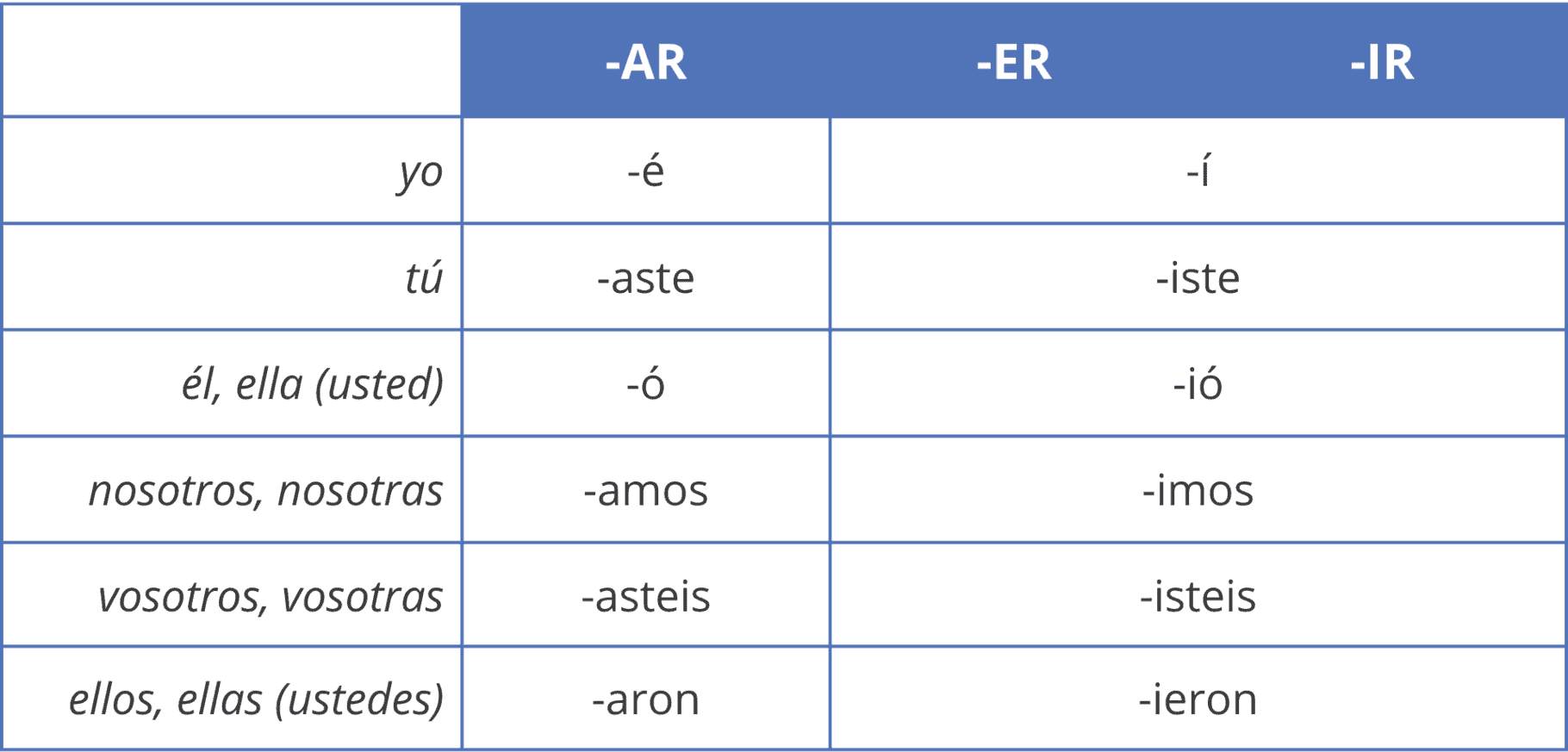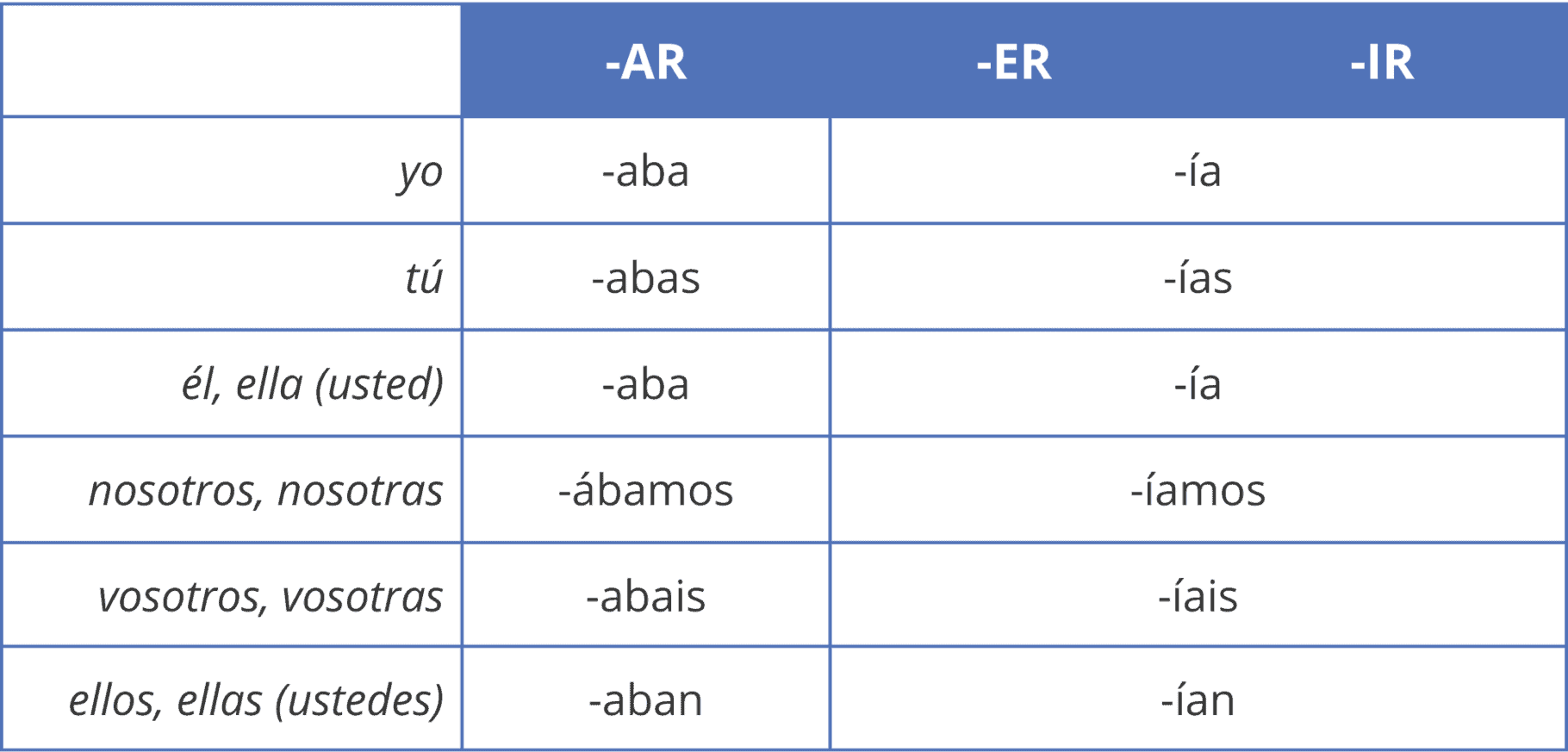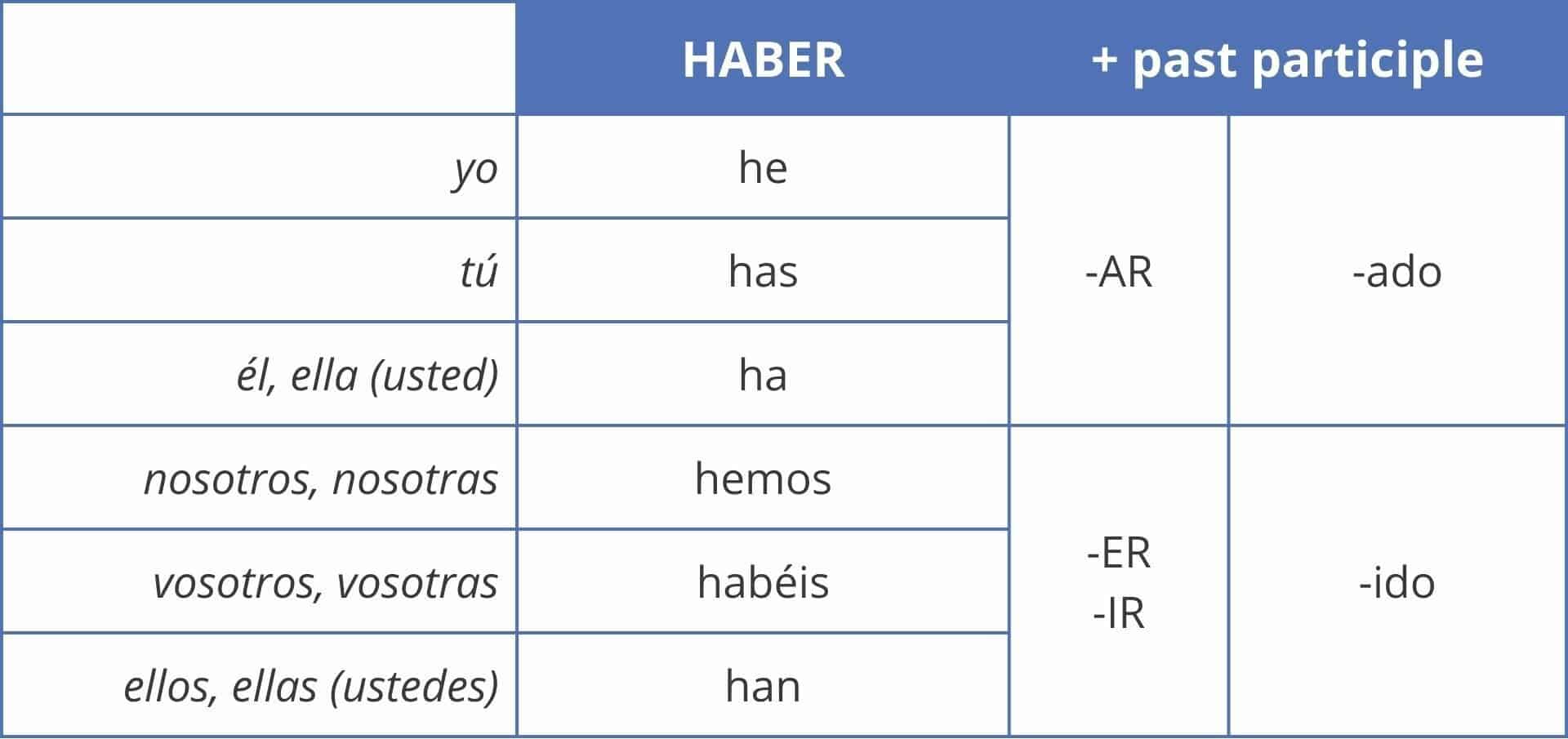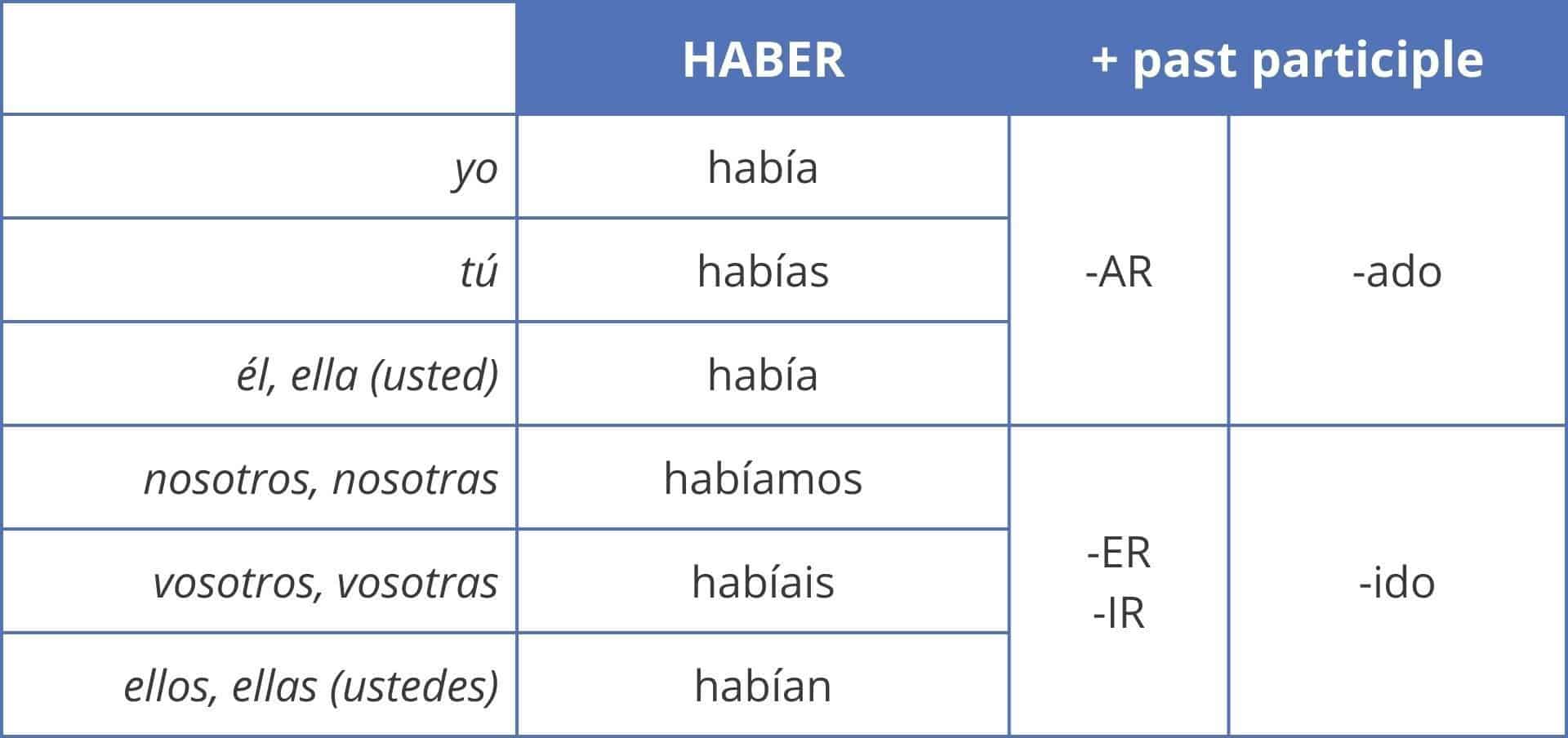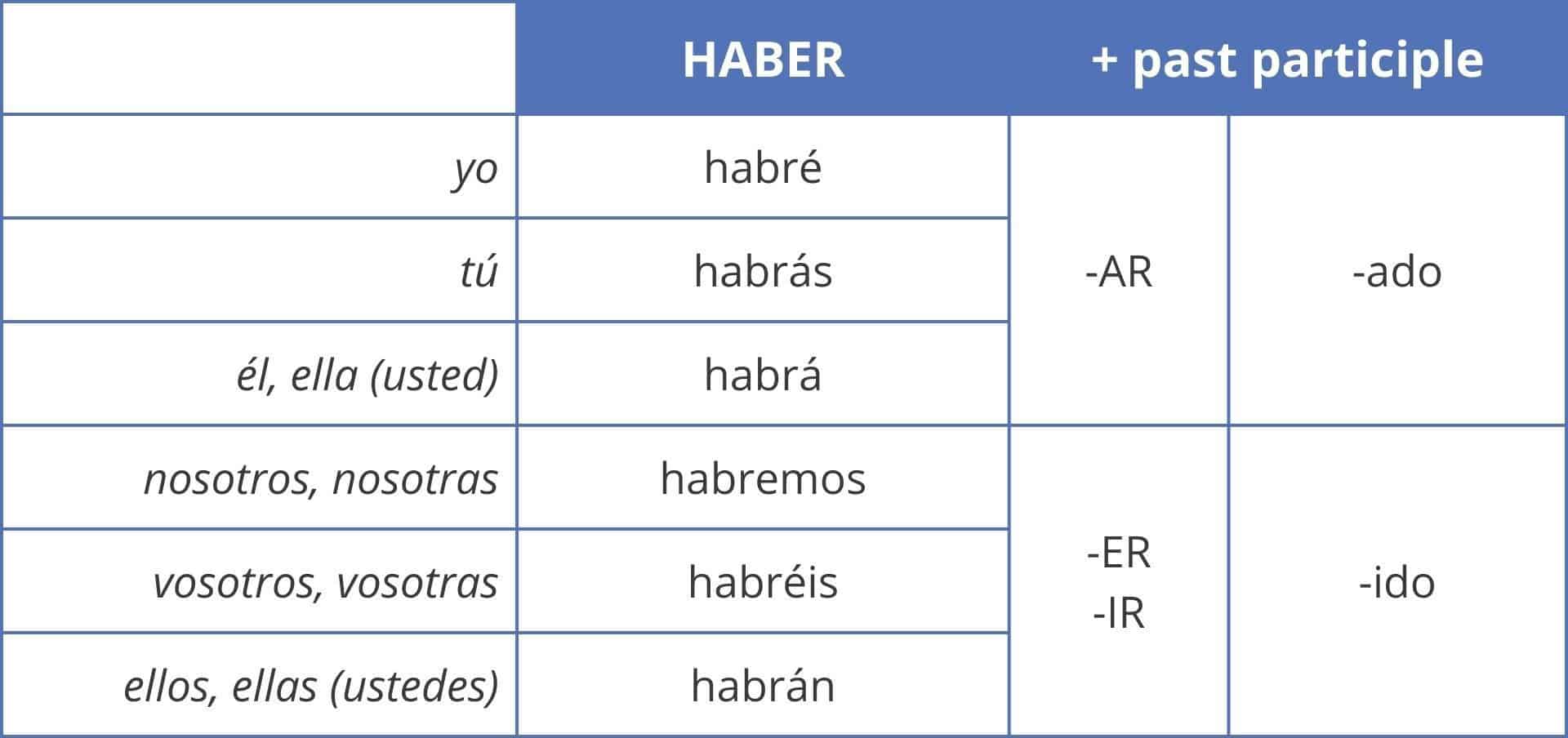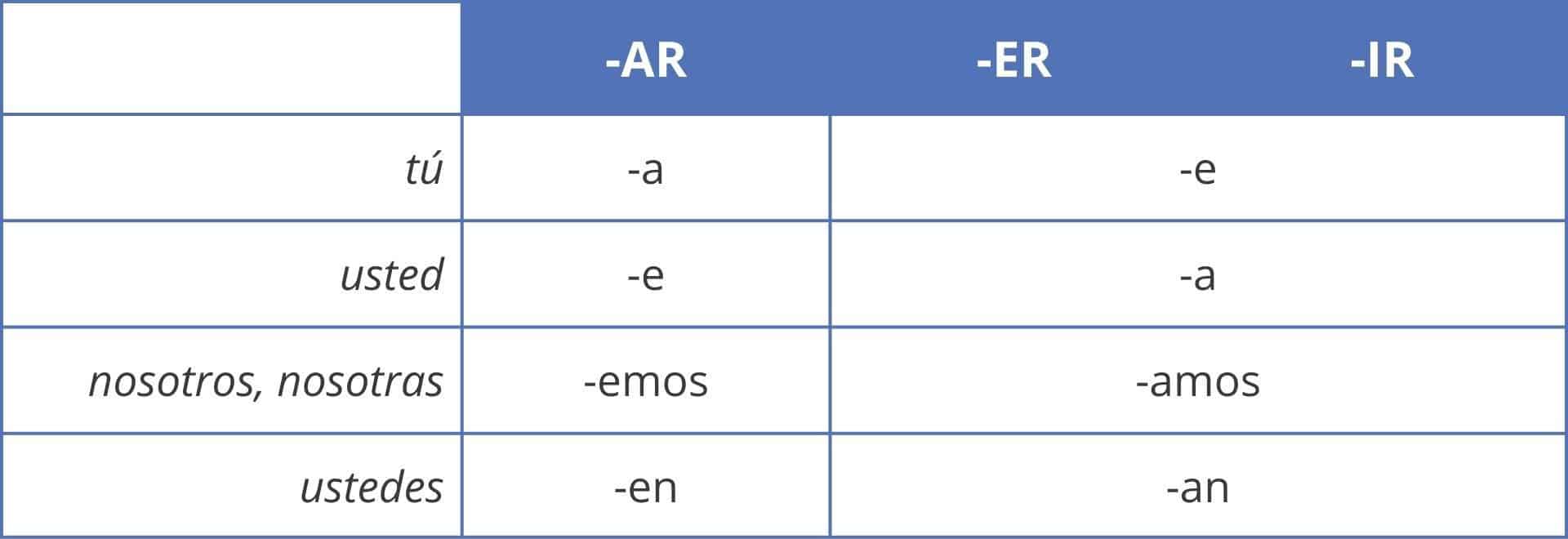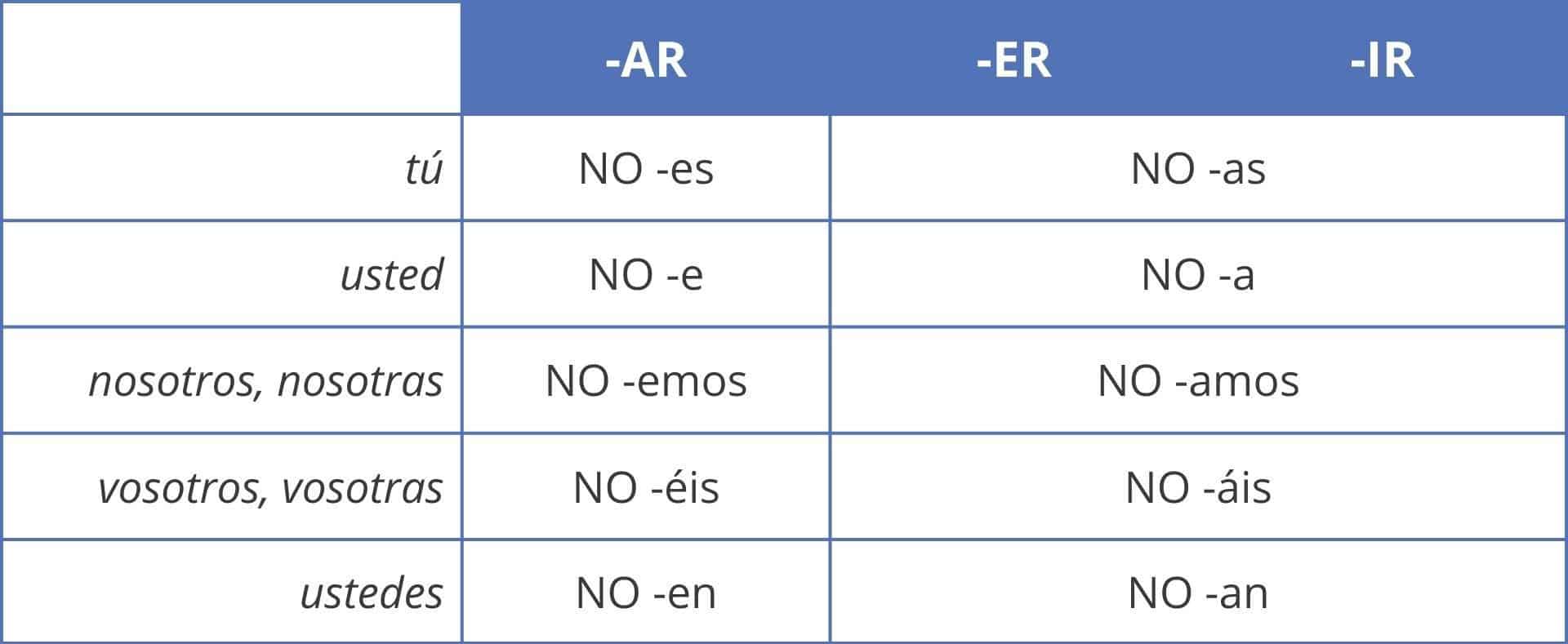Regular Verb Conjugation in Spanish

-
Save
By the time you finish reading this blog post, you will have learned how to conjugate regular verbs in all the tenses that exist. For now, you don’t have to worry about the meaning of the verbs because the idea is to work and practice the form, that is, to systematize the conjugation so that you can do it like a real native speaker. Shall we start?
Look at this table to see the structure of the Spanish verb system:
Non-personal Verb Forms
When a verb is not conjugated it means that it has no person and we say that it is in the infinitive. Infinitive verbs have three conjugations depending on the endings:
Practice!
We conjugate the gerund in a single form for all grammatical persons. To form the gerund of a verb we must remove the ending -AR / -ER / -IR and add -ando / -iendo. Look at the table:
Practice!
We conjugate the past participle in a single form for all grammatical persons. To form the past participle of a verb we must remove the ending -AR / -ER / -IR and add -ado / -ido. Look at the table:
Practice!
Personal Verb Forms
To conjugate the personal forms of an infinitive verb we need to know the personal pronouns in Spanish, that is, the subject pronouns. See the meaning of the personal pronouns:
Now look at how we use personal pronouns to conjugate verbs:
yo
tú
él, ella (usted)
nosotros, nosotras
vosotros, vosotras
ellos, ellas (ustedes)
Attention:
- usted is conjugated as the 3rd person singular, but means 2nd person singular formal.
- ustedes is conjugated as the 3rd person plural, but means 2nd person plural formal in the Peninsula and is also the only form used in America, western Andalusia and the Canary Islands.
To conjugate a verb we must eliminate the ending -AR / -ER / -IR and add the endings depending on the verb tense we want to conjugate and the personal pronoun.
Indicative
Simple Tenses
We conjugate the present simple according to the subject pronoun. To form the present indicative of a verb we must eliminate the ending -AR / -ER / -IR and add:
Practice!
We conjugate the past simple I (pretérito indefinido o pretérito perfecto simple) according to the subject. To form the past simple of a verb we must eliminate the ending -AR / -ER / -IR and add:
Attention!
The persons nosotros and nosotras of regular verbs ending in -AR and -IR have the same form as nosotros and nosotras of the present simple (presente de indicativo).
- En 1980 vivimos en Perú → pretérito perfecto simple o pretérito indefinido
- Ahora vivimos en Chile → presente de indicativo
The tilde in the conjugation of él, ella and usted of verbs in -AR is very important because, as it is not necessary to use the personal pronoun in Spanish, if we do not use the tilde it can be confused with the person yo of the present simple:
- Bailo salsa con Rubén → yo in presente de indicativo
- Bailó salsa con Rubén → él, ella or usted in pretérito perfecto simple o indefinido
Practice!
We conjugate the perfect simple II (pretérito imperfecto) according to the grammatical persons. To form the imperfect preterite of a verb we must eliminate the ending -AR / -ER / -IR and add:
Attention!
The person yo has the same form as the persons él, ella and usted in the preterite imperfect indicative, to differentiate them we can use the personal pronouns. Look at this conversation:
– Estudiaba en Madrid…
+ ¿Tú o tu hermana?
– Yo estudiaba en Madrid, ella estudiaba en Barcelona.
Practice!
We conjugate the future simple (futuro simple o imperfecto) according to the grammatical persons. To form the future simple of a verb we use the infinitive and add these endings: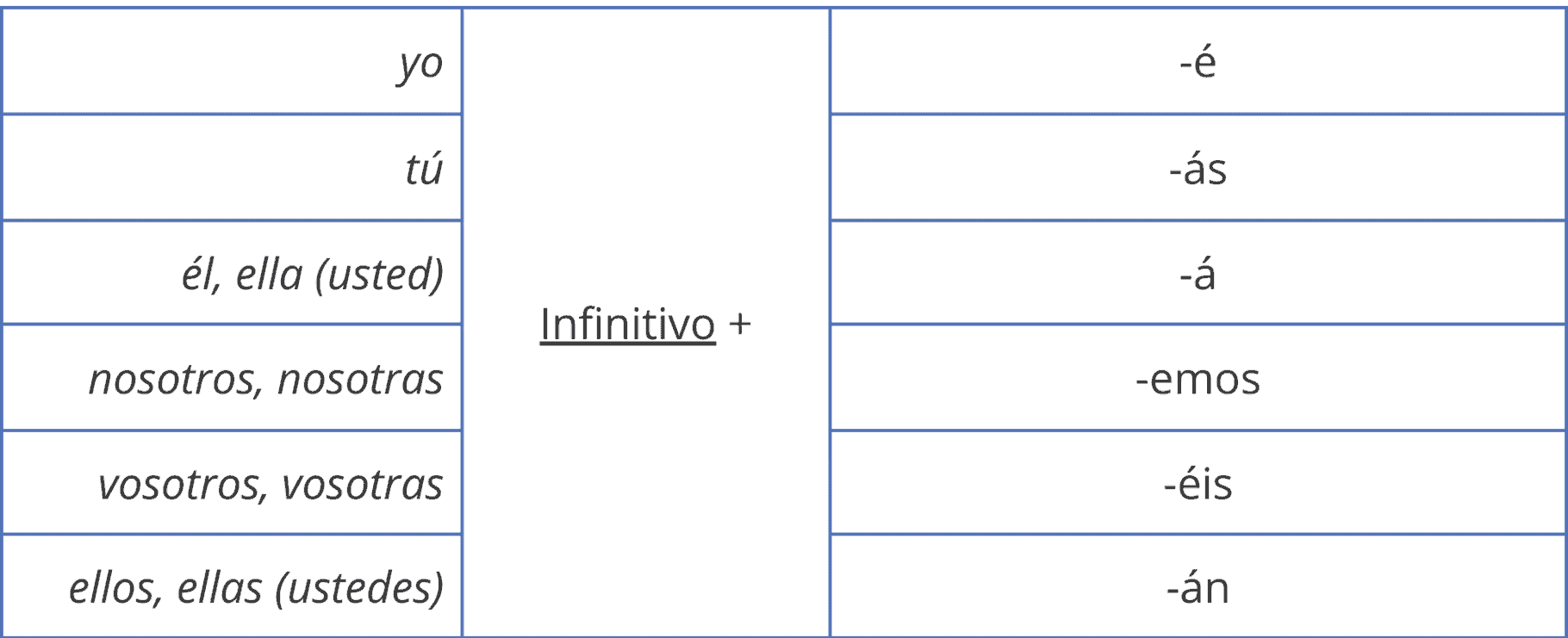
Practice!
We conjugate the conditional: simple forms (condicional simple o imperfecto) according to the subject. To form the “condicional simple” of a verb we use the infinitive and add these endings: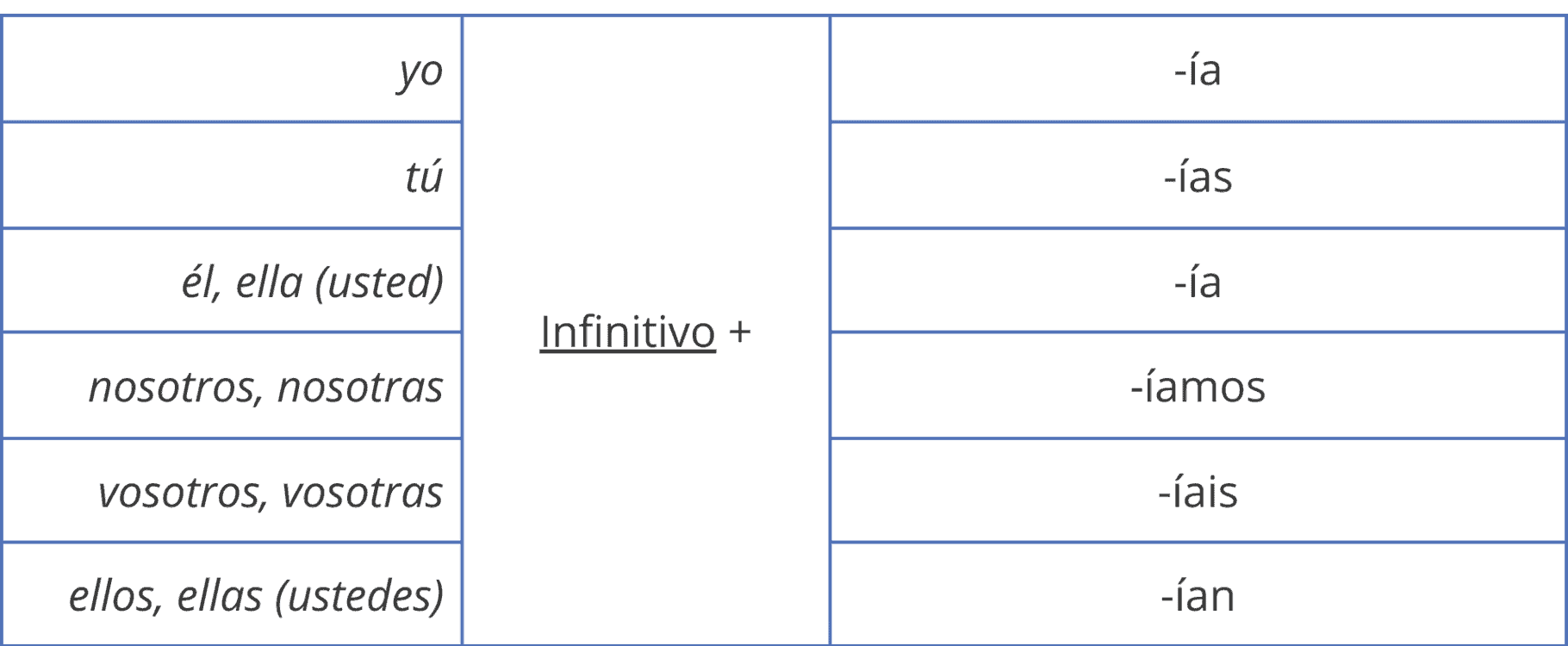
Attention!
The endings of the “condicional simple” are the same as the endings of the verbs in -ER and -Ir of the past simple II (pretérito imperfecto). There is no confusion because the conditional is formed with the infinitive and the past simple II (pretérito imperfecto) is not:
- Antes comía pizza y ahora no → pretérito imperfecto
- Me comería una pizza entera → condicional simple
The person yo (I) has the same form as él, ella and usted in the “condicional simple”, to differentiate them we can use the personal pronouns. Watch the conversation:
- Yo hablaría con ella.
- Ella no hablaría contigo.
Practice!
Compound Tenses
Compound tenses in Spanish are formed with the simple tenses of the verb HABER and the past participle of the verb being conjugated.
We form the present perfect (pretérito perfecto compuesto) by conjugating the verb HABER in the present simple + the past participle of the verb we want to use:
Practice!
We form the past perfect (pretérito pluscuamperfecto) tense by conjugating the verb HABER in the imperfect tense of indicative + the past participle of the verb we want to use:
Practice!
We form the future perfect (futuro compuesto o perfecto) by conjugating the verb HABER in the simple future + the past participle of the verb we want to use:
Practice!
We form the compound forms of the conditional (condicional perfecto o compuesto) by conjugating the verb HABER in the “condicional simple” + the past participle of the verb we want to use: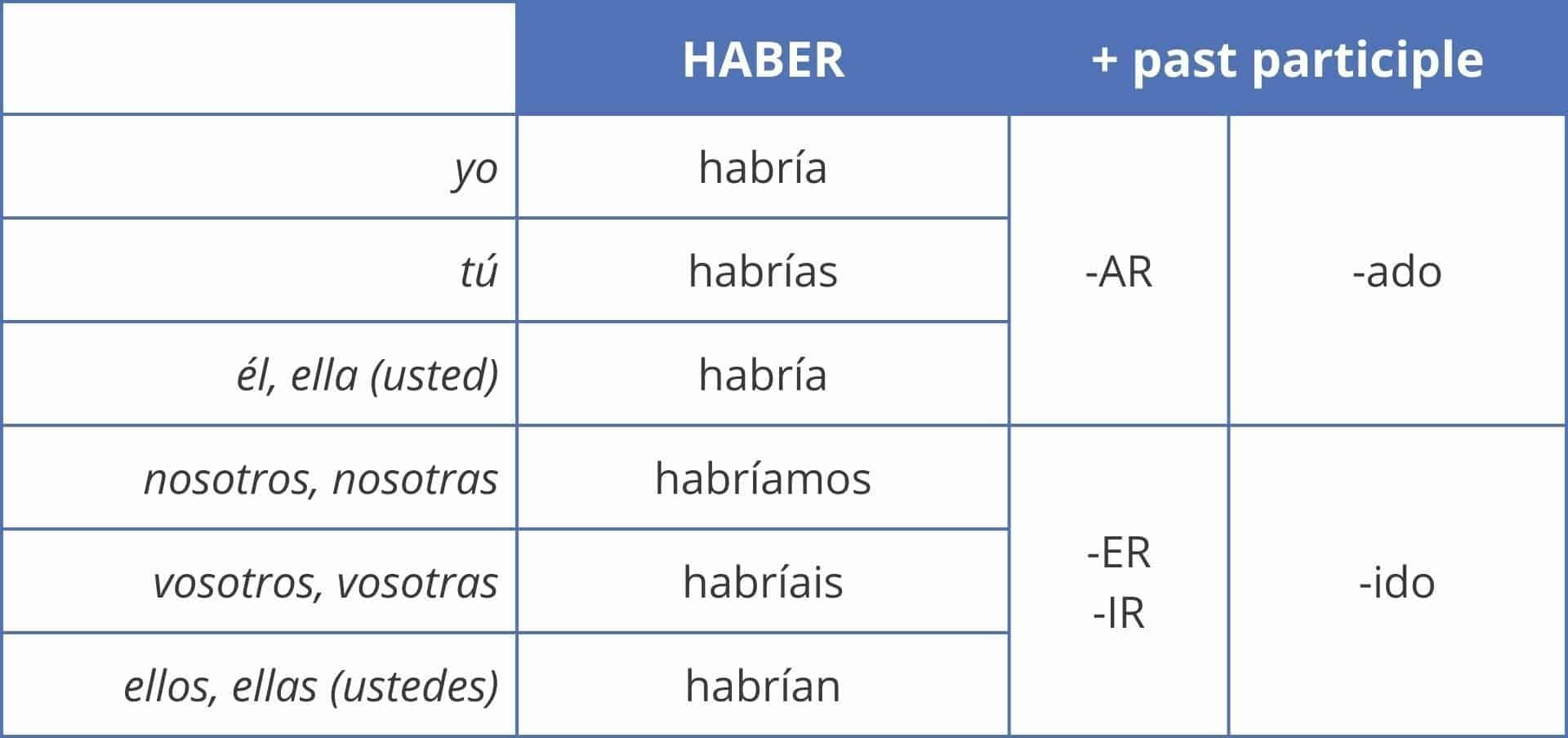
Practice!
Subjunctive
Simple Tenses
We conjugate the present simple (subjunctive) according to the subject pronouns. To form the present simple (subjunctive) of a verb we must eliminate the ending -AR / -ER / -IR and add:
The person yo (I) has the same form as él, ella and usted in the present simple (subjunctive), to differentiate them we can use the personal pronouns. Look at the examples:
- Ojalá yo gane la lotería.
- Ojalá él gane la lotería.
Practice!
We form the past simple II (subjunctive) or pretérito imperfecto de subjuntivo with the 3rd person plural of the past simple I (pretérito perfecto simple o pretérito indefinido). Do you remember this form of the past simple I (pretérito indefinido)? Look at the table:
The past simple II subjunctive (pretérito imperfecto de subjuntivo) has two forms: the forms in -ra and the forms in -se. We conjugate the past simple II subjunctive according to the subject pronouns. To form this tense we must remove the -ron ending and add:
The person yo (I) has the same form as él, ella and usted in the past simple II subjunctive, to differentiate them we can use the personal pronouns. Look at the examples:
- Ojalá yo ganara la lotería.
- Ojalá él ganara la lotería.
Practice!
Compound Tenses
We form the present perfect (subjunctive) by conjugating the verb HABER in the Present Simple Subjunctive + the past participle of the verb we want to use:
Practice!
We form the past perfect (subjunctive) by conjugating the verb HABER in the past simple II (subjunctive) + the past participle of the verb we want to use. Remember that the imperfect subjunctive has two forms:
Practice!
Imperative
Congratulations! 🥳 You’ve reached the end. We hope that the Spanish conjugation now became a little more clearer and you are ready to deepen your knowledge!

-
Save
Would You like to Take Your Spanish to the Next Level?
Whether you’re a complete beginner or you’re an advanced student, with us you’ll reach the next level of Spanish quickly and easily. With 24 Levels to Spanish fluency, the next level is always close by, so you will never lose motivation.
You can choose between:
In both cases, you’ll learn Spanish using our successful 24 Level System to Spanish Fluency® and our unique Spanish teaching methods.
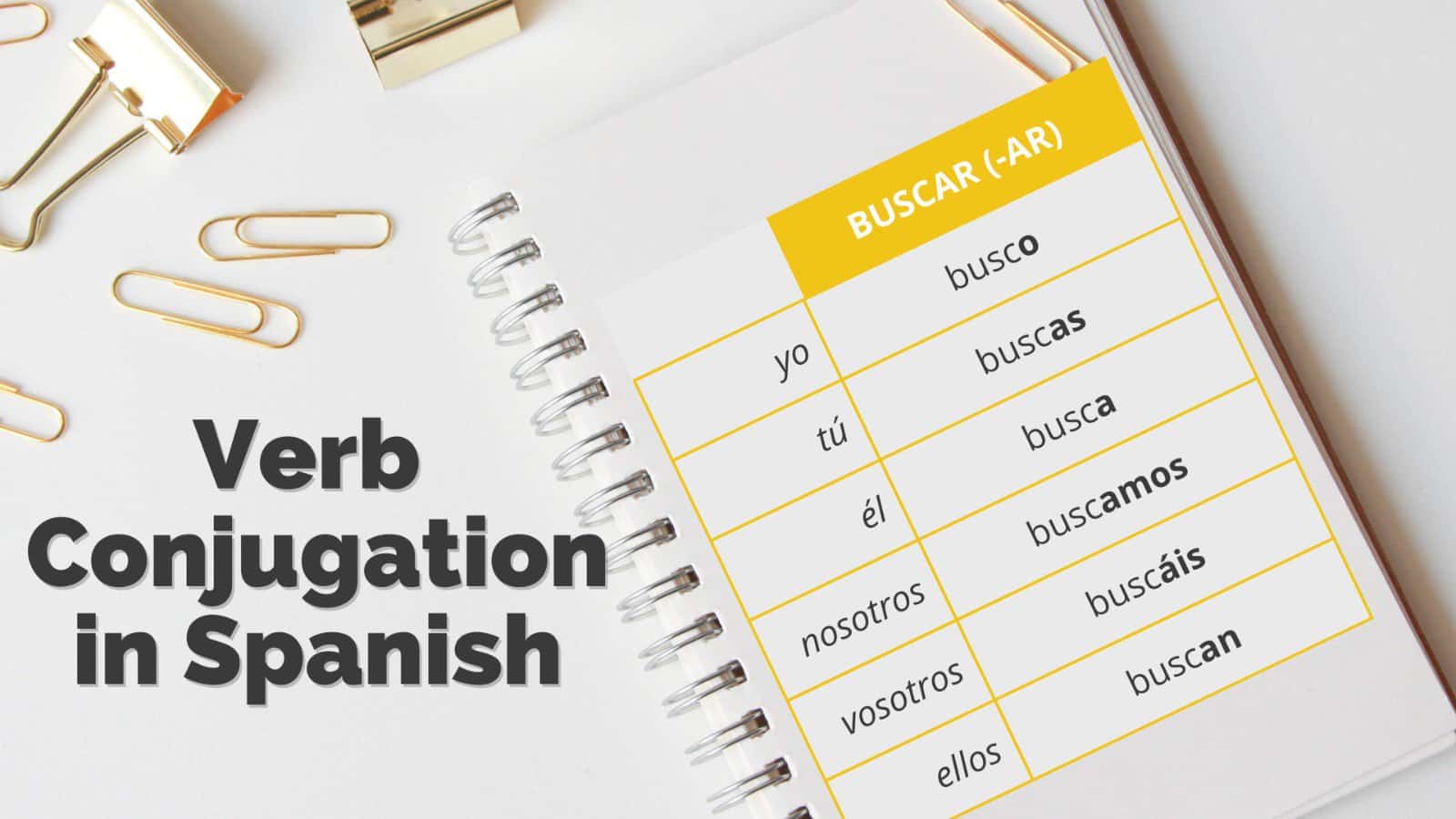
-
Save









